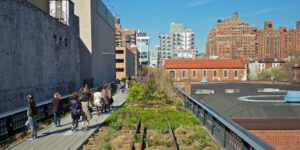
“High Line” – New York’s High Line park: urban green spaces can have environmental benefits, such as reducing urban heating, and also contribute to mental well-being.
Steve Cinderby, Senior Researcher at the SEI York centre, has studied the positive connection between green spaces and well-being, which was the focus of a session at the conference Nature-based Solutions in Tallinn, Estonia – the first international event of its kind. In this Q&A he shares the conclusions of his research and his thoughts about the conference and bringing nature back to cities.
What’s the correlation between well-being and green environments?
Our subjective qualitative data shows that people have a strong preference for these types of spaces and places in our cities. To this, policy-makers and planners might say, “So what? What are the real gains from more green spaces in cities?” But if we add the emerging neurological evidence to this subjective picture, this shows that our brains do in fact react differently in urban green spaces. Green spaces clearly have the potential to contribute to mental well-being, and to help address this emerging global health challenge. The planning issue is how to fit these spaces into congested cityscapes, as well as making sure there is equitable access to green space so everyone can benefit.
It seems that green solutions can also make good business sense. If that is so, why are we only now reaching these conclusions about the benefits of green spaces and green infrastructure? Is it linked to development phases in our society?
Simplistically, I think businesses rely on the bottom-line. Something might be a “nice-to-have”, but ultimately unless it can influence profitability or productivity then they can find it hard to justify. The evidence we have started to contribute to shows that there are sound business reasons – beyond improving the resilience of city spaces, which is a business saving in itself – including increased customer footfall, higher rents for landlords and potentially a happier more productive or environmentally aware workforce.
Developing green infrastructure and green space is a growing trend in cities. And we’re seeing really popular solutions like the High Line in New York. Can you tell us about other interesting projects in the pipeline?
One of the most interesting I think is the London Mayor’s plan to make London a National Park City by 2019, because this could inspire many other cities globally to consider afresh their green and blue spaces. The aim in London is to connect and expand on existing green and blue spaces, and ensure that they are accessible, so those health benefits are available to everyone.
If this can be achieved it should provide environmental benefits across the city and contribute to green infrastructure, particularly as climate change impacts like urban heating and high rainfall events increase. This will hopefully be matched with social and well-being benefits – which is something I would like to monitor.
You presented your research at the Nature-based Solutions conference in Tallinn on 24–26 October, which was part of Estonia’s Presidency of the Council of the European Union. After listening to the speakers and discussions, what’s your view on where nature-based solutions are heading? What can they contribute to sustainable societies?
The speakers in the session I moderated were really inspirational. One was looking at how green spaces across a city can cost-effectively contribute to preventative healthcare. Another was looking at how introducing green spaces into hospitals can provide multiple benefits for both patients and staff. The final speaker was looking at how the EU has been investigating how to include the public in deciding how green infrastructure in cities should look.
I think nature-based solutions are an attractive proposition for dealing with environmental changes that we’re already experiencing – from more frequent severe storms or heavy rainfall, to urban heating and urban flooding – and I think they can contribute to lessening the severity of these impacts. But nature-based solutions need to work alongside other changes like de-carbonizing our economies, low-emission vehicles and resilient urban design. My only concern is the risk that public acceptance or trust in these solutions could be eroded if expectations are too high and they’re seen to “fail”, for example by not “protecting” a community from flooding during particularly severe storms. So, I think these solutions need to work alongside greater involvement of communities in understanding upcoming environmental change.
You arrived at the conference in Estonia in the middle of a snowstorm. How can nature-based solutions work in the northernmost parts of Europe where there is just no greenery for the much of the year?
I think that this is a real knowledge gap – can green spaces provide well-being benefits even in winter, when they aren’t green? I think we need more studies on this. However, one possible alternative in these high latitudes would be including more indoor greening. Near my home city we have the Winter Gardens in Sheffield which is the largest urban glasshouse in Europe. It is right in the heart of the city and publicly accessible. In Thailand I’ve seen examples of indoor greenspace in retail settings. So, I think if we start to provide robust evidence that greening can provide significant health and well-being gains the next challenge is clever design to incorporate as much of it into our cities as we can so that everyone – and the natural environment – can benefit.
Design and development by Soapbox.
